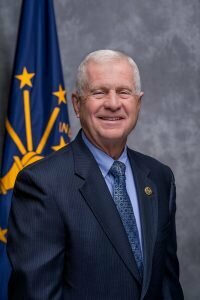 By State Sen. Ed Charbonneau (R-Valparaiso).
By State Sen. Ed Charbonneau (R-Valparaiso).The number one issue facing every sector of the economy today is “workforce.” Fierce competition for workers has resulted. With the unprecedented challenges presented by the COVID-19 pandemic still lingering and new diseases like monkeypox being discovered, it’s critical we have a strong health care workforce.
COVID-19 affected millions of Hoosier families. Simultaneously, it was decimating to our health care workforce, resulting in alarming reports of widespread burnout. Our health care system is scrambling to provide basic services.
Currently, Amazon’s starting wage is $18 per hour plus benefits. In comparison, Indiana’s direct care workers have a median wage of $14.25 per hour for nursing assistants and even less for home health aides.
Pandemic, burnout, workforce shortages and wage inflation have wreaked havoc on the health care industry. Our three most troubling areas include nursing, Long-term Support Services (LTSS), and behavioral health.
Nursing shortages have been most critical in hospitals and long-term care facilities. The number of registered nurses working in the Indiana LTSS sector decreased by nearly 20% from 2019 to 2021.
So, what is being done? In 2019, Indiana became a part of the Nurse Licensure Compact, which gives nurses a multi-state license and allows them to more easily practice across state lines. In 2022, we passed a nursing omnibus bill that addressed many workforce issues, including measures to increase enrollment in nursing schools through expanded use of clinical simulations and adjunct professors. It also allows qualified nurses educated in another country to obtain Indiana licensure in a timelier fashion.
A newly emerging compact enables advanced practice registered nurses (APRNs) to practice across state borders. However, Indiana cannot participate since we don’t license APRNs. This issue will be reviewed during the 2023 session.
We need a comprehensive assessment of Indiana’s nursing workforce pipeline, which will tell us how many students we have across the state and whether we are retaining graduates. Coupling that data with nursing workforce demand will allow the state to create a pipeline plan and make targeted investments.
The LTSS workforce provides supportive and health care services for Hoosiers that are aging or disabled in long-term care facilities and home and community-based services (HCBS) settings. Shortages in this sector are pervasive, and demand for LTSS workers will increase significantly in future years as our population ages.
To address LTSS workforce shortages, Indiana’s Family and Social Services Administration (FSSA) made two rounds of HCBS Stabilization Payments in the amount of $176 million with a requirement that 75% went to their workforce. Evaluation of the outcomes of these funds should be helpful to guide future initiatives.
FSSA is developing an Indiana Direct Service Workforce State Plan focusing on strategies to support the recruitment and retention of Direct Service Workers in LTSS. A rate study looking at competitive wage factors for LTSS workers should lead to a more competitive wage structure.
The behavioral health workforce includes professionals, such as psychologists, social workers, addiction and other mental health counselors, that provide critical counseling services for Hoosiers. These workers practice in various settings, including our state hospitals and community mental health centers.
Currently, all Indiana counties are designated by the federal government as Mental Health Professional Shortage Areas. Indiana administers a National Health Service Corps State Loan Repayment Program to help address health workforce shortages. In 2021, 27 of the 49 recipients were behavioral health professionals.
Last session, behavioral health licenses were specifically excluded from reciprocity provisions implemented in Senate Enrolled Act 5. That decision shall be revisited.
While the shortages are national, the solutions must be found in Indiana.